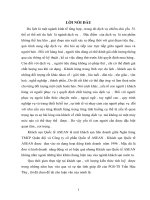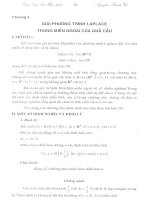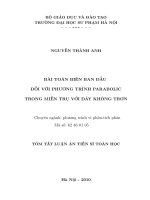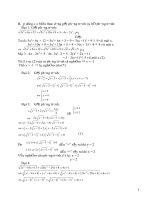- Trang chủ >>
- Toán lớp 12 >>
- Số phức
ĐẲNG THỨC NĂNG LƯỢNG CỦA PHƯƠNG TRÌNH NAVIER-STOKES TRONG MIỀN BỊ CHẶN 3 CHIỀU
Bạn đang xem bản rút gọn của tài liệu. Xem và tải ngay bản đầy đủ của tài liệu tại đây (179.42 KB, 4 trang )
<span class='text_page_counter'>(1)</span><div class='page_container' data-page=1>
Ngo Van Giang – Nguyen Thi Minh Ngoc
ON THE ENERGY EQUALITY OF THE NAVIER – STOKES EQUATIONS IN
BOUNDED THREE DIMENSIONAL DOMAINS
<i>Ngo Van Giang* – Nguyen Thi Minh Ngoc </i>
<i> Thai Nguyen University of Technology </i>
Abstract
The energy equality
1
2‖ ( )‖ + ‖∇ ‖ =
1
2‖ ‖
is an open problem for the Navier-Stokes equations. In this paper we present a condition for the
energy equality of weak solutions to the Navier – Stokes equations in bounded three dimensional
domains. We prove that the energy equality holds for weak solutions in the functional class
(0, ; ) ≥ .
Keywords: Navier – Stokes equations, weak solutions, energy equality, energy inequality, bounded
domain.
1. Introduction
We consider the three dimentional initial
boundary value problem for the Navier –
Stokes equations
− Δ + ( ∙ ∇) + ∇ = 0
in Ω ≔ (0, ) × Ω, = 1,3
(1)
( ) = = 0 Ω
(0, ) = ( ) Ω
where Ω is a smooth bounded domain in
ℝ , ( ) are given functions with ( )
satisfying the condition ( ) = 0.
We recall the definition of weak solutions.
<i>Definition 1.1. A vector field </i>
∈ 0, ; ( ) ∩ (0, ; , <i>( )) </i>
<i>*Tel:0979343995. Email: </i>
<i>is called a weak solution of the Navier – </i>
<i>Stokes equations if the relation </i>
−( , ) <sub>,</sub> + ( , ) <sub>,</sub> − ( , ) <sub>,</sub>
= <i>, (0) _ </i>
<i>is satisfied for all test functions </i> ∈
0, ; , <i>( ) . </i>
In this definition (. , . ) means the usual
pairing of functions on Ω, (. , . ) , means the
corresponding pairing on [0, ) × Ω. Finally
= <sub>,</sub> for = ( , , ) such
that . ∇ = ( . ∇) = ( ) when
( ) = 0.
Leray[3] and Hopf[2] showed the global
existence of weak solutions to Navier – Stokes
equations satisfying the energy inequality
1
2‖ ( )‖ + ‖∇ ‖ ≤
</div>
<span class='text_page_counter'>(2)</span><div class='page_container' data-page=2>
Ngo Van Giang – Nguyen Thi Minh Ngoc
However, the energy equality of weak
solutions
1
2‖ ( )‖ + ‖∇ ‖ =
1
2‖ ‖
is still an open problem. Serrin[4] showed that
if a weak solution u belongs to
0, ; (Ω) for some > 3, > 4with
3
+2≤ 1
then energy equality holds. Later, Shinbrot[5]
derived the same conclusion if the weak
solution u belongs to 0, ; (Ω) for some
> 2, ≥ 4 with
2
+2≤ 1.
Sohr[6] proved the energy equality for
weak solutions if uu belongs to
(0, ; (Ω) .
In the present paper we prove that the
energy equality holds for weak solutions in
the functional class (0, ; ) ≥ . We
have (0, ; )∁ (0, ; ) ≥ with
3
+2
3≤
4
3.
2. Preliminaries
In this section we briefly recall some
standard facts. Let ℙ: (Ω) → (Ω) be the
- orthogonal projection. Let A be the Stokes
operator defined by
= −ℙΔ
The Stokes operator is a self – adjoint
positive vectorial operator with a compact
inverse. Hence, there exists an othornormal
basis of eigenvectors { } in , and a
sequence of positive eigenvalues
≤ ≤ ⋯ ≤ → ∞
such that
= , ∈ ( ).
Let = ( , ), for > 0, we define
the operator by
=
and the space
= { ∈ (Ω):
= , ‖ ‖ = | | < ∞}.
We denote = and its dual.
We recall a trilinear continuous form by
setting
( , , ) =
,
.
This trilinear form is anti – symmetric:
( , , ) = − ( , , ), , , ∈ ,
in particular, ( , , ) = 0 for all , ∈ .
<i>Lemma 2.1. Let </i> : [0, ) → <i> be a weakly </i>
<i>continuous weak solution of Navier – Stokes </i>
<i>equations on [0, ), let </i>
=
:
<i> then, </i>
| ( )| + 2 ‖ ‖
= | | + 2
→ ( , , )
</div>
<span class='text_page_counter'>(3)</span><div class='page_container' data-page=3>
Ngo Van Giang – Nguyen Thi Minh Ngoc
<i>Proof: </i>
One can see from our assumption that
∈ (0, ; ) and ∈ (0, ; ).
Thus, using as a test function we obtain
− (0) + 2
= 2 , , .
From this we see that the limit of the right
hand side exists as → ∞, which completes
the proof of the lemma.
3. Main result
Let = − , we have the inequality
following:
Let ∈ , >
= | |
:
= . | |
:
≤ ( ). | |
:
≤ ( ).
⇒ ≤
= | |
:
= . | |
:
≤ ( ).
⇒ ≤ .
<i>Theorem 3.1. Let </i> <i>⊂ ℝ be a bounded </i>
<i>domain and let u be a weak solution of the </i>
<i>Navier </i> <i>– </i> <i>Stokes </i> <i>equations, </i> <i>suppose </i>
<i>additionally that </i>
∈ (0, ; <i>) </i>
<i>for some </i> <i>≥ . Then, the energy equality </i>
<i>holds </i>
1
2‖ ( )‖ + ‖ ‖ =
1
2‖ <i>‖ </i>
<i>for all </i> <i>∈ [0, ). </i>
<i>Proof: </i>
In view of Lemma 2.1, it suffices to show
that
lim
→ ( , , ) = 0
to this end let us write
( , , ) = ( , , ) + ( , , )
+ ( , , ) + ( , , ).
The last two terms vanish, so it suffices to
estimate only the first two. We use the
inequality (see [1])
| ( , , )| ≤ ‖ ‖ . ‖ ‖ . ‖ ‖
where + + ≥ .
We have, for some ≥
( , , ) ≤ . .
≤ . . . . .
≤ . . .
We choose < , < , + 1 > ,
and + + + 1 = 3 . Hence
( , , ) ≤ . .
</div>
<span class='text_page_counter'>(4)</span><div class='page_container' data-page=4>
Ngo Van Giang – Nguyen Thi Minh Ngoc
( , , ) ≤ ‖ ‖ < ∞
for all t, by the Dominated Convergence
Theorem
( , , ) → 0 as → ∞
in (0, ). As to the second term, similar
estimates
( , , ) ≤ .
which also tends to zero in (0, ) as
→ ∞.
References
<i>[1] P. Constantin, C. Foias, (1988), Navier </i>
<i>Stokes Equations, Chicago Lect. Math. Univ </i>
of Chicago Press. Chicago.
[2] E. Hopf, (1951), <i>Uber </i> <i>Die </i>
<i>Anfangswertaufgabe </i> <i>fur </i> <i>Die </i>
<i>Hydrodynamischen Grund – Gleichungen, </i>
Math. Nachr. 4, 213 – 231.
<i>[3] J. Leray, (1934), Sur le Mouvement D’un </i>
<i>Liquide Visqueux Emplissant L’espace, Acta </i>
Math. 63, 193 – 248.
<i>[4] J. Serrin, (1977), Navier-Stokes Equations </i>
<i>Theory And Numerical Analysis. </i>
North-Holland publishing Company Amsterdam,
New York, Oxford.
<i>[5] M. Shinbrot, (1974), The Energy Equation </i>
<i>for The Navier – Stokes System, SIAM J. </i>
Math. Anal. 5, 948 – 954.
<i>[6] H. Sohr, (2001), The Navier – Stokes </i>
<i>Equations, Birkhauser Verlag, Basel. </i>
ĐẲNG THỨC NĂNG LƯỢNG CỦA PHƯƠNG TRÌNH NAVIER-STOKES TRONG MIỀN BỊ CHẶN
3 CHIỀU
<i>Ngô Văn Giang, Nguyễn Thị Minh Ngọc </i>
<i>Trường Đại học Kỹ thuật Công nghiệp Thái Nguyên </i>
Tóm tắt
Đẳng thức về năng lượng
1
2‖ ( )‖ + ‖∇ ‖ =
1
2‖ ‖
là một vấn đề mở đối với hệ phương trình Navier – Stokes. Trong bài báo này chúng tôi đưa ra một điều kiện
cho đẳng thức năng lượng của nghiệm yếu trong hệ phương trình Navier – Stokes trong khơng gian ba chiều
có miền bị chặn. Chúng tơi chứng minh rằng đẳng thức năng lượng sẽ được giữ nếu nghiệm yếu của phương
trình Navier – Stokes thuộc lớp hàm (0, ; ) ≥ .
</div>
<!--links-->









